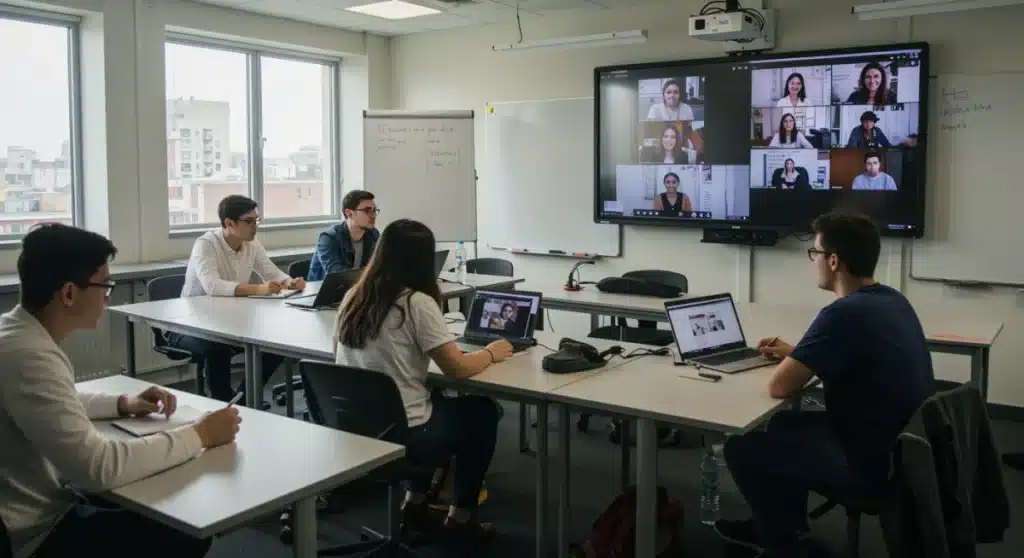Hybrid Learning Models in Higher Ed: 2025 Updates

As of late 2024, the landscape of higher education is undergoing a profound transformation, with Hybrid Learning Models emerging as a dominant force. Universities worldwide are rapidly adapting their strategies, driven by technological advancements and evolving student needs, ensuring that the educational experience remains relevant and engaging for 2025 and beyond.
The Evolution of Hybrid Learning: Beyond Emergency Remote Teaching
Hybrid learning, once a response to global crises, is now a cornerstone of modern higher education. The initial scramble to move courses online has matured into sophisticated, intentional designs that blend face-to-face and virtual instruction, aiming to optimize learning outcomes and student flexibility. This evolution is marked by a deliberate shift from reactive measures to proactive pedagogical innovation.
Institutions are investing heavily in infrastructure and faculty development to support these advanced models. The objective is no longer merely to deliver content, but to create cohesive, interactive learning ecosystems that leverage the strengths of both physical and digital environments.
Redefining Engagement in Hybrid Spaces
Engaging students effectively in a hybrid setting presents unique challenges and opportunities. Educators are now employing diverse strategies to ensure active participation from both in-person and remote learners.
- Interactive Virtual Platforms: Utilizing sophisticated video conferencing tools with breakout rooms, polls, and Q&A features to foster real-time interaction.
- Asynchronous Activities: Designing flexible assignments, discussion forums, and self-paced modules that accommodate different time zones and learning styles.
- Blended Group Projects: Facilitating collaborative projects where students from both modalities work together, simulating real-world team dynamics.
These approaches are crucial for maintaining a sense of community and ensuring equitable access to learning experiences, regardless of physical location.
Technological Innovations Driving Hybrid Model Advancement
The continuous advancement of educational technology is a primary catalyst for the sophistication of Hybrid Learning Models. From AI-powered learning tools to immersive virtual realities, 2025 is set to witness a surge in innovative solutions that enhance both delivery and engagement.
Universities are actively exploring and implementing cutting-edge technologies to bridge the gap between physical and virtual classrooms. This includes advanced audio-visual setups in lecture halls, robust learning management systems (LMS) with enhanced analytics, and personalized learning pathways. The goal is to create a seamless and enriched educational experience for all students.
AI and Adaptive Learning Pathways
Artificial intelligence is playing an increasingly vital role in personalizing the hybrid learning experience. AI-driven platforms can analyze student performance data to identify areas where learners struggle, offering targeted resources and adaptive assessments.
- Personalized Feedback: AI tools providing instant, constructive feedback on assignments and quizzes.
- Adaptive Content Delivery: Adjusting the pace and complexity of course material based on individual student progress.
- Predictive Analytics: Identifying at-risk students early on, allowing educators to intervene proactively.
These innovations ensure that hybrid learning is not a one-size-fits-all solution but rather a dynamic and responsive system tailored to individual needs.
Pedagogical Shifts and Faculty Development
A critical component of successful Hybrid Learning Models is the evolution of teaching methodologies and the robust support for faculty. Educators are no longer just content deliverers; they are facilitators, instructional designers, and tech integrators. This requires significant investment in professional development and a shift in institutional culture.
The emphasis is now on active learning strategies, project-based learning, and fostering critical thinking skills, regardless of the learning modality. Faculty are being trained to design courses that fluidly transition between synchronous and asynchronous activities, ensuring coherence and engagement across the hybrid spectrum. This pedagogical transformation is essential for maximizing the potential of these new models.

Designing for Dual Modality
Designing courses for hybrid delivery demands a nuanced approach that considers the distinct needs of both in-person and remote learners. This involves careful planning of activities, resources, and assessment methods.
- Integrated Course Materials: Ensuring all learning resources are accessible and equally effective for both physical and virtual participants.
- Synchronous Session Structuring: Planning live sessions that actively involve remote learners, preventing them from feeling like passive observers.
- Assessment Equity: Developing assessment strategies that are fair and valid across both modalities, utilizing technology to ensure academic integrity.
Effective hybrid design ensures that neither group feels disadvantaged, promoting an inclusive learning environment.
Accessibility and Inclusivity in Hybrid Education
One of the most significant advantages and ongoing challenges of Hybrid Learning Models is ensuring accessibility and inclusivity for all students. As higher education moves towards more flexible structures, it becomes paramount to address the diverse needs of learners, including those with disabilities, varying socio-economic backgrounds, and different learning preferences.
Universities are increasingly focusing on universal design for learning (UDL) principles to create environments that are inherently accessible. This includes providing captions for all video content, offering alternative formats for materials, and designing interfaces that are navigable for assistive technologies. The goal is to break down barriers to education, making it available to a broader demographic.
Addressing Digital Divides and Equity
The digital divide remains a significant concern, and hybrid models must actively work to mitigate its impact. Ensuring equitable access to technology and reliable internet connectivity is crucial for remote learners.
- Device Loaner Programs: Providing laptops or tablets to students who lack personal access.
- Subsidized Internet Access: Partnering with internet providers or offering subsidies to help students afford connectivity.
- Digital Literacy Training: Offering workshops and resources to enhance students’ technological skills, ensuring they can navigate online learning effectively.
These initiatives are vital for fostering true equity in hybrid learning environments, ensuring that no student is left behind due to technological disadvantages.
Measuring Success and Continuous Improvement
As Hybrid Learning Models become more ingrained in higher education, the focus is shifting towards robust methods for measuring their effectiveness and implementing continuous improvements. Data analytics and feedback mechanisms are crucial for understanding what works, what doesn’t, and how to optimize the learning experience.
Institutions are employing sophisticated learning analytics to track student engagement, performance, and satisfaction across both online and in-person components. This data-driven approach allows for agile adjustments to curriculum design, technological infrastructure, and pedagogical strategies, ensuring that hybrid models evolve to meet the dynamic needs of students and educators.
Key Metrics for Hybrid Learning Evaluation
Evaluating the success of hybrid models goes beyond traditional academic performance. It encompasses a holistic view of the student experience and operational efficiency.
- Student Engagement Rates: Tracking participation in both synchronous and asynchronous activities.
- Learning Outcome Achievement: Comparing academic results between hybrid and traditional cohorts.
- Faculty Satisfaction: Gauging educator experiences with hybrid teaching tools and support.
- Resource Utilization: Analyzing the effectiveness of technological investments and infrastructure.
Regular feedback surveys and focus groups also provide qualitative insights, complementing quantitative data for a comprehensive understanding of hybrid learning impact.
Emerging Trends and Future Outlook for 2025
Looking ahead to 2025, several emerging trends are poised to further shape the evolution of Hybrid Learning Models in higher education. These developments underscore a commitment to innovation, flexibility, and student-centered design, pushing the boundaries of what is possible in educational delivery.
We anticipate a greater integration of micro-credentials and modular learning within hybrid frameworks, allowing students to tailor their educational pathways more precisely to career goals. Furthermore, the role of virtual reality and augmented reality is expected to expand, offering immersive learning experiences that were once confined to science fiction. These trends point towards an increasingly dynamic and personalized future for higher education.
The Rise of Immersive Learning Experiences
Immersive technologies are set to revolutionize how students interact with course content, particularly in hybrid settings. Virtual and augmented reality offer unprecedented opportunities for experiential learning.
- Virtual Labs and Simulations: Providing hands-on experience in fields like medicine, engineering, and science, accessible from anywhere.
- Augmented Reality Field Trips: Enhancing real-world learning with digital overlays that provide contextual information.
- Metaverse Classrooms: Creating persistent virtual spaces where students and educators can interact, collaborate, and learn in a truly immersive environment.
These technologies promise to make complex concepts more tangible and engaging, fostering deeper understanding and retention.
| Key Trend | Brief Description |
|---|---|
| Advanced Tech Integration | Increased use of AI, VR/AR, and analytics for personalized and immersive learning experiences. |
| Pedagogical Innovation | Shift to active learning, dual-modality design, and enhanced faculty development. |
| Enhanced Accessibility | Focus on universal design, addressing digital divides, and promoting equity in access. |
| Micro-credentials & Modularity | Greater adoption of flexible learning pathways and stackable qualifications. |
Frequently Asked Questions About Hybrid Learning
A hybrid learning model intentionally combines face-to-face classroom instruction with online learning activities. It aims to leverage the best aspects of both modalities, offering students flexibility while maintaining opportunities for in-person interaction and hands-on experiences, tailored for optimal learning outcomes.
Universities are implementing various strategies, including providing device loaner programs, offering subsidized internet access, and conducting digital literacy training. The goal is to ensure all students, regardless of socio-economic background, have equitable access to the technology and skills needed for successful participation in hybrid courses.
AI is crucial for personalizing hybrid learning by providing adaptive content, instant feedback, and predictive analytics. It helps identify student struggles early and offers tailored resources, making learning more efficient and effective for individual needs and diverse learning styles, ultimately enhancing the educational experience.
Educators face challenges such as designing engaging content for dual modalities, managing technology effectively, and ensuring equitable participation from both in-person and remote students. Continuous professional development and institutional support are essential to overcome these hurdles and foster successful hybrid learning environments.
By 2025, immersive technologies like VR and AR are expected to create highly engaging virtual labs, simulations, and interactive field trips. These tools will enable students to experience complex concepts in tangible ways, enhancing understanding and retention, and fostering a more dynamic and experiential hybrid learning environment.
Looking Ahead: The Enduring Impact of Hybrid Learning
The current trajectory for Hybrid Learning Models indicates a future where flexibility and personalization are paramount in higher education. As institutions continue to refine their approaches and integrate cutting-edge technologies, the focus remains on creating inclusive, engaging, and effective learning environments that cater to a diverse student body. The developments seen in late 2024 and projected for 2025 are not merely temporary adjustments but foundational shifts. Expect ongoing innovation in pedagogical design and technological integration, ensuring that higher education remains responsive and relevant in an ever-evolving global landscape.





